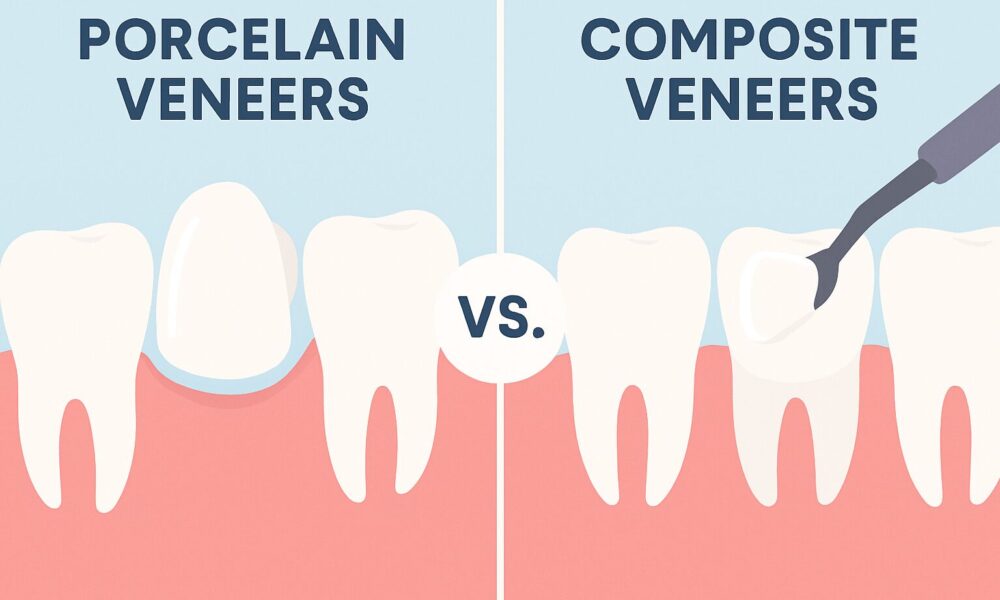Porcelain Veneers vs. Composite Veneers: Which Is Right for You

So, if you want to give a beautiful smile a try, then veneers are the solution you were looking for!
But the question here is which ones to opt for composite veneers or porcelain veneers. Choosing the best alternative is not an easy task and both of them has their pros and cons list.
Well, to ease your decision-making and cover all the factors, we have created this in-depth guide of porcelain veneers vs. composite veneers. So lets discuss both the types of veneers in detail:
What Are Porcelain Veneers?
Porcelain veneers are translucent porcelain materials thin shells that are placed on your teeth’s front. Porcelain veneers are custom made and fits perfectly with your teeth giving them a natural look and feel.
The Pros of Porcelain Veneers:
- They have a natural look: They provide the perfect look and appearance resembling your natural teeth.
- Stain Resistance: You will never stain porcelain with food and drinks, and your smile will be bright.
- Versatile: These veneers are used in correcting severe discoloration, spacing, and other cosmetic imperfections.
Cons of Porcelain Veneers:
- Irreversible process: The dentist has to take away some enamel on the tooth, so the damage is irreversible.
- Longer Treatment Duration: Since porcelain veneers in austin tx are prepared in a lab, they need several appointments.
- More Expensive: The overall cost of a dental implant ranges from $925 to $2,500 per tooth.
- Challenging Repairs: Repairing damaged porcelain veneers is more challenging and expensive than composite veneers.
How is porcelain veneer applied?
Applying porcelain veneers is a simple process and might take upto 2 to 3 sittings.
- Tooth Preparation: A thin layer of enamel needs to be removed in order to prepare the room for your veneer.
- Getting the impression: A copy of your teeth is taken and sent to the lab for the preparation of the veneer.
- Temporary Veneers: Temporary veneers may be placed for helping you get get comfortable with the permanent ones.
- Final Placement: The tailor-made veneers are bonded over your teeth with a high strength bonding agent and then sealed with photopolymerised resin.
What Are Composite Veneers?
Composite veneers are made of tooth-coloured resin material and are applied directly to the teeth.
Pros of Composite Veneers
- Composite veneers are more on the affordable side. They cost between $250 and $1,500 per tooth.
- No laboratory work is needed for them, making them able to be done in a single visit.
- The last possibility is Reversibility: it’s low preparation and can be easily undone should that be necessary.
- Less expensive repairs: The cost of repair is much less if a composite veneer chip or damage occurs.
Cons of Composite Veneers
- Not long-lasting: Composite veneers do not last more than 5 to 7 years and require more frequent replacements.
- Stains easily: Composite material is usually porous and so it discolors faster.
- Less Aesthetic Appeal — Although they look natural, they do not provide the light reflecting properties which porcelain does.
- Not as Versatile: Composite veneers might not be suitable in cases of greater staining or space problems.
How is Composite Veneer applied?
The dentist determines the correct resin shade for your teeth.
- Sculpting: Resin material is sculpted and applied directly onto the teeth.
- Curing: A high intensity light hardens the resin.
- Finishing: Veneers are polished to be natural-looking.
Porcelain vs Composite Veneers: The Main Differences
Time
- Composite veneers are done in one visit.
- Porcelain veneers require 2 to 3 visits over a few weeks.
Longevity
- With proper maintenance, porcelain veneers can last 10-20 years.
- Composite veneers also last for 5-7 years and require more regular renewal.
Aesthatics
- Porcelain veneers have a translucent property that can look exactly like the enamel in your real teeth.
- Composite veneers look nice but don’t have the same light-reflecting intensity as porcelain.
Cost
- Porcelain veneers initially cost more but last longer.
- Composite veneers are cheaper but require frequent repairs or replacements.
Making the Right Choice
What veneer is best for you will vary based on your individual needs. Here’s a table comparing the benefits of Composite Veneers and Porcelain Veneers:
| Feature | Composite Veneers | Porcelain Veneers |
| Cost | Cheaper alternative to porcelain veneers. | More expensive than composite veneers. |
| Speed | Fast application. | Longer application process. |
| Durability | Less durable compared to porcelain veneers. | Long-term and highly durable. |
| Aesthetics | Good, but not as natural-looking. | Most aesthetic appearance with a natural look. |
| Stain Resistance | Prone to staining and discoloration over time. | Highly resistant to stains and discoloration. |
| Tooth Preparation | Requires less tooth preparation. | Requires more tooth preparation. |
| Repair & Maintenance | Easy to repair and maintain. | Difficult to repair; replacement may be needed. |
| Best For | Quick, affordable solution. | Extreme aesthetic issues and long-term results. |
Conclusion
The choice between the two completely depends on personal preferences and denstit’s suggestion. People who need scratched-proof and tarnish-proof veneers with high aesthetics, can go for porcelain veneers. But, if somebody is looking for a more economical and faster rehabilitation, composite veneers can be a better option.
But whichever one you choose between them, both can dramatically enhance your smile and subsequently your confidence. Consult with the best dentist in bee cave to find one that’s best for you.





